North Sea: Difference between revisions
Created page with 'right|thumb|350px|The North Sea from space The '''North Sea''' is a marginal sea of the Atlantic Ocean, lying between Great Britain as its w…' |
|||
| Line 336: | Line 336: | ||
[[File:Queen Elizabeth and King George Docks - geograph.org.uk - 324157.jpg|right|thumb|250px|Queen Elizabeth and King George Docks, Hull]] | [[File:Queen Elizabeth and King George Docks - geograph.org.uk - 324157.jpg|right|thumb|250px|Queen Elizabeth and King George Docks, Hull]] | ||
Fishing boats, service boats for offshore industries, sport and pleasure craft, and merchant ships to and from North Sea ports | Fishing boats, service boats for offshore industries, sport and pleasure craft, and merchant ships to and from North Sea ports and Baltic ports must share routes on the North Sea. The Straits of Dover alone sees more than 400 commercial vessels a day.<ref>{{cite web| url=http://www.mcga.gov.uk/c4mca/mcga07-home/emergencyresponse/mcga-searchandrescue/mcga-hmcgsar-sarsystem/channel_navigation_information_service__cnis_/the_dover_strait.htm| title=The Dover Strait| publisher=Maritime and Coastguard Agency| year=2007| accessdate=2008-10-08}}</ref> Because of this volume, navigation in the North Sea can be difficult in high traffic zones, so ports have established elaborate vessel traffic services to monitor and direct ships into and out of port.<ref name="Freestone">{{cite book | ||
|last=Freestone | |last=Freestone | ||
|first=David | |first=David | ||
| Line 346: | Line 346: | ||
|pages=186–190 | |pages=186–190 | ||
}} | }} | ||
</ref> | </ref> | ||
==Outside links== | ==Outside links== | ||
Latest revision as of 17:07, 8 February 2020
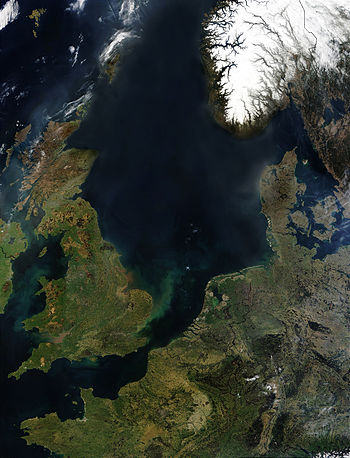
The North Sea is a marginal sea of the Atlantic Ocean, lying between Great Britain as its western edge, and Europe to the south and east; Scandinavia lies to the west across the sea, and the coasts of Germany, the Netherlands and Belgium sweep round form the east to the south to the Straits of Dover, which mark its southern limit, west of which is the English Channel. To the north of Shetland, the sea opens out into the Atlantic Ocean and that part of it known as the Norwegian Sea. Thus the sea connects with the ocean to the north and the south of Britain. It also gives access in the east to the Baltic Sea; another rich trade route for the ports of Britain's east coast.
The North Sea is a relatively shallow sea for the most part in comparison with the oceans and topographically it is considered an epeiric (or "shelf") sea on the European continental shelf. In reckoning the area of the sea from Dover to Orkney, it comes to some 600 miles long, 360 miles broad and 290,000 square miles in area. Its long coasts on all sides are lined with ports, fishing villages and industry.
In addition to the trading ships and fishing boats (and warships) which have plied the North Sea since prehistory, the North Sea has recently become a source of energy; it has rich oil and gas fields and latterly wind, wave and tidal power have begun to be exploited.
Name
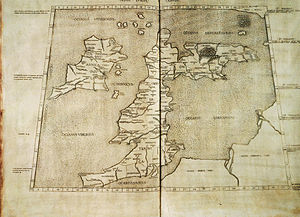
Through history |various names have been used for the North Sea. One of the earliest recorded names was Septentrionalis Oceanus, or "Northern Ocean," which was cited by Pliny.[1] The name "North Sea" probably came into English, however, from the Dutch "Noordzee", and the Dutch named it thus either in contrast with the Zuiderzee ("South Sea"), located south of Frisia, or simply because the sea is generally to the north of the Netherlands.[2] The names "German Sea" or "German Ocean" (from the Latin name "Mare Germanicum" and "Oceanus Germanicus") were the names commonly used in English until the universal adoption of the current name, and they persisted into the late 19th century.[3] The name "North Sea" was in widespread use long before the First World War, when any remaining use of "the German Ocean" would have been banished.
In Old English the sea is not specifically named, though the Englisc translation of Bede refers to the Britons' being slain from eastsæ (east sea) unto westsæ (west sea). Ohtere refers to the sea west of Norway as the Westsæ, but all these are compass-point markers and need not refer to actual names given to the sea.
In Danish, the term "Vesterhavet" (literally "the western ocean") is used as frequently as Nordsøen ("the north sea") as synonym for the North Sea.
Geography
The North Sea is conventionally bounded by the Orkney islands and east coast of Great Britain to the west and the northern and central European mainland to the east and south, including Norway, Denmark, Germany, the Netherlands and Belgium. In the southwest, beyond the Straits of Dover, the North Sea gives way to the English Channel connecting to the Atlantic Ocean. In the east the Skagerrak and Kattegat between Denmark in the south and Norway and Sweden respectively in the north gives access to the Baltic Sea. In the north it is bordered by the Shetland islands, north of which is the open ocean or the Norwegian Sea; the latter's northernmost part.
Around the edges of the North Sea are several sizeable islands and archipelagos, of which the greatest island is Great Britain.
For the most part, the North Sea lies on the European continental shelf with a mean depth of 300 feet,[4][5] apart from the deep Norwegian Trench, off the Norse coast.
The Dogger Bank, a vast undersea plain, rises so that the depth here is a mere 50 to 100 feet.[6][7] The Dogger Bank has produced the finest fishing location of the North Sea.[4] The Devil's Hole lies 200 miles east of Dundee, Angus. The feature is a series of asymmetrical trenches between 13 and 20 miles long, a mile or so wide and up to 125 fathoms deep.[8]
Extent
The International Hydrographic Organization defines the limits of the North Sea for its purposes as follows:[9]
On the Southwest. A line joining the Walde Lighthouse (France, 1°55'E) and Leathercoat Point (England, 51°10'N).[10]
On the Northwest. From Dunnet Head (3°22'W) in Scotland to Tor Ness (58°47'N) in the Island of Hoy, thence through this island to the Kame of Hoy (58°55'N) on to Breck Ness on Mainland (58°58'N) through this island to Costa Head (3°14'W) and to Inga Ness (59'17'N) in Westray through Westray, to Bow Head, across to Mull Head (North point of Papa Westray) and on to Seal Skerry (North point of North Ronaldsay) and thence to Horse Island (South point of the Shetland Islands).
On the North. From the North point (Fethaland Point) of the Mainland of the Shetland Islands, across to Graveland Ness (60°39'N) in the Island of Yell, through Yell to Gloup Ness (1°04'W) and across to Spoo Ness (60°45'N) in Unst island, through Unst to Herma Ness (60°51'N), on to the SW point of the Rumblings and to Muckle Flugga (60°51'N 0°53'W) all these being included in the North Sea area; thence up the meridian of 0°53' West to the parallel of 61°00' North and eastward along this parallel to the coast of Norway, the whole of Viking Bank being thus included in the North Sea.
On the East. The Western limit of the Skagerrak [A line joining Hanstholm 57°07'N 83°6'E and the Naze (Lindesnes) 58°N 7°E].
Natural history
Fish and shellfish
Copepods and other zooplankton are plentiful in the North Sea. These tiny organisms are crucial elements of the food chain supporting many species of fish. Over 230 species of fish live in the North Sea. Cod, haddock, whiting, saithe, plaice, sole (fish)|sole, mackerel, herring, pouting, sprat, and sandeel are all very common and are fished commercially.[11] Due to the various depths of the North Sea trenches and differences in salinity, temperature, and water movement, some fish such as blue-mouth redfish and rabbitfish reside only in small areas of the North Sea.[12]
Crustaceans are also commonly found throughout the sea. Norway lobster, deep-water prawns, and brown shrimp are all commercially fished, but other species of lobster, shrimp, oyster, mussels and clams all live in the North Sea. Recently non-indigenous species have become established including the Pacific oyster and Atlantic jackknife clam.[11]
Birds
The coasts of the North Sea are rich in sea birds. Tens of millions of birds make use of the North Sea for breeding, feeding, or migratory stopovers every year. Populations of Black legged Kittiwakes, Atlantic Puffins, Northern fulmars, and species of petrels, gannets, seaducks, loons (divers), cormorants, gulls, auks, and terns, and many other seabirds make these coasts popular for birdwatching.[11]
Marine mammals
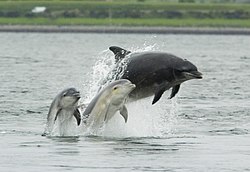
The North Sea is also home to marine mammals. Common seals, and Harbour porpoises can be found along the coasts, at marine installations, and on islands. The very northern North Sea islands such as the Shetland Islands are occasionally home to a larger variety of seals including bearded, harp, hooded and ringed seals, and even walrus.[13] North Sea cetaceans include various porpoise, dolphin and whale species.[11][14]
History
Early history
The North Sea has provided waterway access for commerce and conquest. Many areas have access to the North Sea with its long coastline and European rivers that empty into it.[4] The British Isles had been protected from invasion by the North Sea waters[4] until the Roman conquest of Britain in 43 AD. The Romans established organised ports, shipping increased and sustained trade began.[15] When the Romans abandoned Britain in 410 the Germanic Angles, Saxons, and Jutes began the next great migration across the North Sea during the Migration Period invading Britain.[16]
The Viking Age began in 793 with the attack on Lindisfarne and for the next quarter-millennium the Vikings ruled the North Sea. In their superior longships, they raided, traded, and established colonies and outposts on the Sea's coasts. From the Middle Ages through the 15th century, the northern European coastal ports exported domestic goods, dyes, linen, salt, metal goods and wine. The Scandinavian and Baltic areas shipped grain, fish, naval necessities, and timber. In turn the North Sea countries imported high grade cloths, spices, and fruits from the Mediterranean region[17] Commerce during this era was mainly undertaken by maritime trade due to underdeveloped roadways.[17]
In the 13th century the Hanseatic League, though centred on the Baltic Sea, started to control most of the trade through important members and outposts on the North Sea.[18] Some British towns joined the League or allied with it. The League lost its dominance in the 16th century, as neighbouring states took control of former Hanseatic cities and outposts and internal conflict prevented effective cooperation and defence.[19] Furthermore, as the League lost control of its maritime cities, new trade routes emerged that provided Europe with Asian, American, and African goods.[20][21]
Age of sail
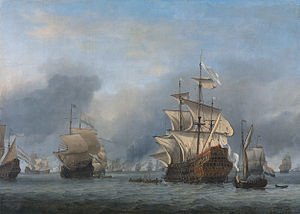
The 17th century Dutch Golden Age during which Dutch herring, cod and whale fisheries reached an all time high[17] saw Dutch power at its zenith.[22][23] Important overseas colonies, a vast merchant marine, powerful navy and large profits made the Dutch the main challengers to an ambitious England. This rivalry led to the first three Anglo-Dutch Wars between 1652 and 1673.[23] After the Glorious Revolution the Dutch prince William ascended the British throne as King William III. With both countries united, commercial, military, and political power shifted from Amsterdam to London.[24] The Great Northern War (1700–21) and the War of the Spanish Succession (1701–1714) were fought concurrently.[25]
British naval power did not face a challenge to its dominance of the North Sea until the 20th century.[26]
Modern era
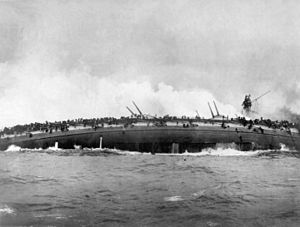
Tensions in the North Sea were again heightened in 1904 by the Dogger Bank incident, in which Russian naval vessels mistook British fishing boats for Japanese ships and fired on them, and then upon each other.
During the First World War, Great Britain's Grand Fleet and Germany's Kaiserliche Marine faced each other on the North Sea,[27] which became a theatre of war. After victory at the Battle of Jutland, the Royal Navy was able to establish an effective blockade for most of the war that restricted Germany's access to many crucial resources.[28] Major battles included the Battle of Heligoland (1914),[29] the Battle of the Dogger Bank,[30] and the Battle of Jutland.[30]
The Great War also brought the first extensive use of submarine warfare, and a number of submarine actions occurred in the North Sea.[31]
The Second World War also saw action in the North Sea, though it was restricted more to aerial reconnaissance, air battles, submarines and smaller vessels such as minesweepers, and torpedo boats and similar vessels.
After the war, the North Sea lost much of its military significance because it is bordered only by NATO member-states. However, it gained significant economic importance in the 1960s as the states on the North Sea began full-scale exploitation of its oil and gas resources. The North Sea continues to be an active trade route.[32]
Fishing
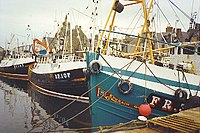
The North Sea is Europe's main fishery accounting for over 5% of international commercial fish caught.[4] Fishing in the North Sea is concentrated in the southern part of the coastal waters. The main method of fishing is trawling.[33] In 1995, the total volume of fish and shellfish caught in the North Sea was approximately 3.5 million tons.[34] Besides fish, it is estimated that one million tons of unmarketable by-catch is caught and discarded each year.[35]
In recent decades, overfishing has left many fisheries lean, disturbing marine food chain dynamics and costing jobs in the fishing industry.[36] </ref> One objective of the European Union Common Fisheries Policy is to minimize the environmental impact associated with resource use by reducing fish discards, increasing output of fisheries, stabilising markets of fisheries and fish processing, and supplying fish at reasonable prices for the consumer.[37]
Marine traffic
The North Sea is important for marine transportation and its shipping lanes are among the busiest in the world. Major ports are located along its coasts: Rotterdam, the busiest port in Europe is the third busiest port in the world by tonnage. Antwerp, Hamburg, Bremen/Bremerhaven and Felixstowe are all in the top 30 busiest container seaports in the world.
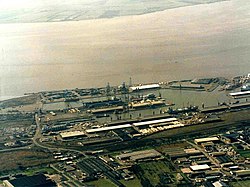
Fishing boats, service boats for offshore industries, sport and pleasure craft, and merchant ships to and from North Sea ports and Baltic ports must share routes on the North Sea. The Straits of Dover alone sees more than 400 commercial vessels a day.[38] Because of this volume, navigation in the North Sea can be difficult in high traffic zones, so ports have established elaborate vessel traffic services to monitor and direct ships into and out of port.[39]
Outside links
| ("Wikimedia Commons" has material about North Sea) |
- The North Sea in brief
- See Interactive Map over Oil and Gas Resources in the North Sea
- Etymology and History of Names
- North Sea Commission Environment Group Member Profiles 2006 (910 KB)
- Old map: Manuscript chart of the North Sea, VOC, ca.1690 (high resolution zoomable scan)
- Overview of geography, hydrography and climate of the North Sea 2.9 MB
- Silver Pit chart
- The Jurassic-Cretaceous North Sea Rift Dome and associated Basin Evolution 2.5 MB
- OSPAR Commission Homepage an international commission designed to protect and conserve the North-East Atlantic and its resources
- North Sea Region Programme 2007–2013 transnational cooperation programme under the European Regional Development Fund
- North Sea Microorganisms: 60+ images of Foraminifera
References
- ↑ Roller, Duane W. (2006). "Roman Exploration". Through the Pillars of Herakles: Greco-Roman Exploration of the Atlantic. Taylor and Francis. p. 119. ISBN 0415372879. "Footnote 28. Strabo 7.1.3. The name North Sea, more properly "Northern Ocean." Septentrionalis Oceanus, first appears at this time; the earliest extant citation is Pliny, Natural History 2.167, 4.109."
- ↑ North Sea Online Etymology Dictionary
- ↑ German Oxford English Dictionary
- ↑ 4.0 4.1 4.2 4.3 4.4 Encyclopaedia Britannica
- ↑ Calow, Peter (1999). Blackwell's Concise Encyclopedia of Environmental Management. Blackwell Publishing. ISBN 0632049510.
- ↑ Ostergren, Robert Clifford; John G. Rice (2004). The Europeans: A Geography of People, Culture, and Environment. Bath, UK: Guilford Press. p. 62. ISBN 0898622727.
- ↑ Dogger Bank. Maptech Online MapServer. 1989–2008.
- ↑ Alan Fyfe (Autumn 1983). "The Devil's Hole in the North Sea". The Edinburgh Geologist (14). http://www.edinburghgeolsoc.org/edingeologist/z_14_04.html/. Retrieved 2008-11-02.
- ↑ "Limits of Oceans and Seas, 3rd edition". International Hydrographic Organization. 1953. http://www.iho-ohi.net/iho_pubs/standard/S-23/S23_1953.pdf. Retrieved 6 February 2010.
- ↑ Leathercoat Point is at the north end of St Margaret's Bay, Kent (51°10'N 1°24'E).
- ↑ 11.0 11.1 11.2 11.3 "Quality Status Report for the Greater North Sea" (PDF). Convention for the Protection of the Marine Environment of the North-East Atlantic (OSPAR). 2000. http://www.bmu.de/files/pdfs/allgemein/application/pdf/kapitel5_ospar_report.pdf. Retrieved 2007-12-21.
- ↑ (PDF) Factors affecting the distribution of North Sea fish. International Council for the Exploration of the Sea ICES. 2003. http://www.ices.dk/marineworld/fishmap/pdfs/factors.pdf. Retrieved 2007-12-09.
- ↑ Marine mammals in the waters of the North Sea. The North Sea Bird Club. 2002-12-11. http://www.abdn.ac.uk/nsbc/mar_mammals.hti. Retrieved 2007-12-21.
- ↑ Whales and dolphins in the North Sea 'on the increase'. Newcastle University Press Release. 2005-04-02. http://www.ncl.ac.uk/press.office/press.release/item/?ref=1112607082. Retrieved 2007-12-21.
- ↑ Cuyvers, Luc (1986). The Strait of Dover. BRILL. p. 2. ISBN 9024732522, 9789024732524.
- ↑ Green, Dennis Howard (2003). The Continental Saxons from the Migration Period to the Tenth Century: An Ethnographic Perspective. Frank Siegmund. Boydell Press. pp. 48–50. ISBN 1843830264, 9781843830269.
- ↑ 17.0 17.1 17.2 Smith, H. D. (1992). The British Isles and the Age of Exploration – A Maritime Perspective. 26. 483–487. doi:10.1007/BF02665747.
- ↑ {{cite journal |last = Hansen |first = Mogens Herman |title =A Comparative Study of Thirty City-state Cultures: An Investigation |page = 305 |publisher =Kgl. Danske Videnskabernes Selskab |year = 2000 |isbn=8778761778, 9788778761774
- ↑ Køppen, Adolph Ludvig; Karl Spruner von Merz (1854). The World in the Middle Ages. New York: D. Appleton and Company. p. 179. OCLC 3621972.
- ↑ Ripley, George R; Charles Anderson Dana (1869). The New American Cyclopædia: A Popular Dictionary of General Knowledge. New York: D. Appleton. p. 540.
- ↑ Cook, Harold John (2007). Matters of Exchange: Commerce, Medicine, and Science in the Dutch Golden Age. Yale University Press. p. 7. ISBN 9780300117967.
- ↑ 23.0 23.1 Findlay, Ronald; Kevin H. O'Rourke (2007). Power and Plenty: Trade, War, and the World Economy in the Second Millennium. Princeton University Press. p. 187 and 238. ISBN 069111854X, 9780691118543.
- ↑ MacDonald, Scott (2004). A History of Credit and Power in the Western World. Albert L. Gastmann. Transaction Publishers. pp. 122–127, 134. ISBN 0765808331.
- ↑ Brand, Hanno (2007). The Dynamics of Economic Culture in the North Sea and Baltic Region: In the Late Middle Ages and Early Modern Period. Leos Müller. Uitgeverij Verloren. p. 46. ISBN 9065508821.
- ↑ Sondhaus, Lawrence (2001). Naval Warfare, 1815–1914. New York: Routledge. p. 183. ISBN 0415214785.
- ↑ Halpern, Paul G. (1994). A naval history of World War I. Ontario: Routledge. pp. 29, 180. ISBN 1857284984.
- ↑ Tucker, Spencer (2005-09) [2005]. World War I: Encyclopedia. Priscilla Mary Roberts. New York, USA: ABC-CLIO. pp. 836–838. ISBN 1851094202.
- ↑ Osborne, Eric W. (2006). The Battle of Heligoland Bight. London: Indiana University Press. p. Introduction. ISBN 0253347424.
- ↑ Tucker, Spencer; Priscilla Mary Roberts (2005-09) [2005]. World War I: Encyclopedia. London: ABC-CLIO. pp. 165, 203, 312. ISBN 1851094202, 9781851094202.
- ↑ "Forth Ports PLC". 2008. http://www.forthports.co.uk/ports/. Retrieved 2007-11-11.
- ↑ Sherman, Kenneth; Lewis M. Alexander, Barry D. Gold (1993). Large Marine Ecosystems: Stress, Mitigation, and Sustainability (3, illustrated ed.). Blackwell Publishing. pp. 252–258. ISBN 087168506X.
- ↑ "MUMM – Fishing". Royal Belgian Institute of Natural Sciences. 2002–2008. http://www.mumm.ac.be/EN/NorthSea/fishing.php. Retrieved 2008-11-29.
- ↑ "One Million Tons of North Sea Fish Discarded Every Year". Environment News Service (ENS). 2008.. http://www.ens-newswire.com/ens/nov2008/2008-11-05-03.asp. Retrieved 2007-12-09.
- ↑ Clover, Charles (2004). The End of the Line: How overfishing is changing the world and what we eat. London: Ebury Press. ISBN 0-09-189780-7.
- ↑ Olivert-Amado, Ana (2008-03-13). The common fisheries policy: origins and development. European Parliament Fact Sheets. http://www.europarl.europa.eu/facts_2004/4_3_1_en.htm. Retrieved 2007-07-19.
- ↑ "The Dover Strait". Maritime and Coastguard Agency. 2007. http://www.mcga.gov.uk/c4mca/mcga07-home/emergencyresponse/mcga-searchandrescue/mcga-hmcgsar-sarsystem/channel_navigation_information_service__cnis_/the_dover_strait.htm. Retrieved 2008-10-08.
- ↑ Freestone, David (1990). link. ed. The North Sea: Perspectives on Regional Environmental Co-operation. Martinus Nijhoff Publishers. pp. 186–190. ISBN 1853334138.
Books
- Starkey, David J.; Morten Hahn-Pedersen (2005). Bridging troubled waters: Conflict and co-operation in the North Sea Region since 1550. Esbjerg [Denmark]: Fiskeri-og Søfartsmuseets. ISBN 8790982304.
- Ilyina, Tatjana P (2007). The fate of persistent organic pollutants in the North Sea multiple year model simulations of [gamma]-HCH, [alpha]-HCH and PCB 153Tatjana P Ilyina;. Berlin ; New York: Springer. ISBN 9783540681632.
- Karlsdóttir, Hrefna M. (2005). Fishing on common grounds: the consequences of unregulated fisheries of North Sea Herring in the postwar period. Göteborg: Ekonomisk-Historiska Inst., Göteborg Univ.. ISBN 9185196622.
- Tiedeke, Thorsten; Werner Weiler (2007). North Sea coast: landscape panoramas. Nelson: NZ Visitor; Lancaster: Gazelle Drake Academic. ISBN 9781877339653.
- ed. by Erik Thoen (2007). Rural history in the North Sea area: a state of the art (Middle Ages – beginning 20th century). Turnhout: Brepols. ISBN 9782503510057.
- Waddington, Clive; Kristian Pedersen (2007). Mesolithic studies in the North Sea Basin and beyond: proceedings of a conference held at Newcastle in 2003. Oxford: Oxbow Books. ISBN 1842172247.
- Zeelenberg, Sjoerd (2005). Offshore wind energy in the North Sea Region: the state of affairs of offshore wind energy projects, national policies and economic, environmental and technological conditions in Denmark, Germany, The Netherlands, Belgium and the United Kingdom. Groningen: University of Groningen. OCLC 71640714.
